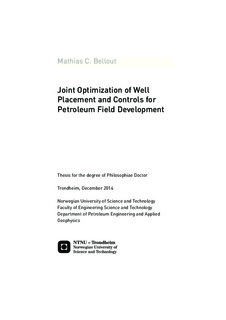| dc.description.abstract | In this thesis we optimize the drilling location and operational controls of wells in a joint
manner to improve the overall development strategy for a petroleum field. In particular,
in this thesis we treat the integrated problem of searching for an improved well placement
configuration while also taking into account the control settings of the production
and/or injector wells planned for the development of the hydrocarbon asset. In oil field
development, the well placement and well control problems are commonly performed in a
sequential manner. However, this type of sequential approach cannot be expected to yield
optimal solutions because it relies on handling well production controls using heuristic
techniques during the well placement part of the procedure. In this work, we develop a
nested (joint) optimization approach that seeks to capture the interdependency between
the well configuration and the associated controls during the optimization search.
This thesis summarizes the development of the joint approach; from establishing the
methodology while using relatively simple cases and performing thorough comparisons
against sequential approaches, to further extending and finally testing the methodology
using a real field case model. This progression naturally divides the work in this thesis
into two parts with different research focus. The first part of this work (Chapter 2)
focuses chiefly on creating proper definitions and on establishing the proposed methodology
against common approaches. The second part of this thesis (Chapters 3 and 4), on
the other hand, focuses mainly on applying the developed methodology within a real field
case scenario involving the North Sea Martin Linge oil reservoir. The dual aim of this
application work is both to further develop the methodology, and to produce and test optimization
solutions that may serve as decision–support to engineering efforts within the
development work process of the Martin Linge field.
Chapter 2 establishes the core of the methodology followed in this thesis. This chapter
introduces the joint and sequential approaches as different ways to solve for the coupled
well placement and control problem. The joint approach embeds the well control
optimization within the search for optimum well placement configurations. Derivative–
free methods based on pattern search are used to solve for the well–positioning part of
the problem, while the well control optimization is solved by sequential quadratic programming
using gradients efficiently computed through adjoints. Compared to reasonable
sequential approaches, the joint optimization yields a significant increase in net present
value of up to 20%. Compared to the sequential procedures, though, the joint approach
requires about an order of magnitude increase in the total number of reservoir simulations
performed during optimization. This increase, however, is somewhat mitigated by the parallel implementation of some of the pattern search algorithms used in this work.
Chapter 3 focuses on extending and applying the methodology developed in the previous
chapter within a real field development scenario. A work process loop is set up to
guide the entire application effort; from work model validation and problem definition,
to optimization effort and solution testing. Results from the optimization effort, using an
approximated work model, yield a mean increase in FOPT of close to 33% for solutions
developed using the joint approach. In comparison, solutions developed using a sequential
approach yield a mean increase in FOPT of almost 26%. Moreover, cost function
evolution data for the joint runs using the field case work model, show that the performance
of less promising locations during the well placement search may be improved
significantly due to the embedded control routine. This supports the notion that the nested
routine may contribute to a smoothing of the outer loop optimization surface with respect
to the well placement variables, and that this smoothing may add some robustness to the
well placement search conducted by the joint approach. Furthermore, as seen previously
in Chapter 2, the cost of the joint approach is still substantially higher compared to the
computation required by the sequential alternatives. For the application work in Chapter
3, the mean total number of reservoir simulations required by the joint runs is almost 7
times higher than the mean total number of reservoir simulations needed by the sequential
runs.
In Chapter 4, the well placement solutions obtained using the work model are transferred
and tested on to the original field case model for the Martin Linge oil reservoir. A
main result from the overall testing shows that those well placement configurations with
B wells that aggressively target the eastern lobe of the Martin Linge oil reservoir yield
the greatest increases in field oil production total. Furthermore, the various well placement
solutions are tested for two realistic field development considerations that were not
included in the optimization effort, i.e., the original larger production time frame and a
multiple realizations field case scenario. Compared to the initial well configuration for the
single–realization case, the best–performing well placement solution yields an increase in
field oil production total of, respectively, 25.5% for the time frame used in the optimization
procedure, and of 13% for the original (larger) production horizon. However, we note
that we performed the optimization effort using only a single realization. Consequently,
the solutions developed from this procedure are observed to lose most of their gains once
these well configurations are implemented for both the larger production time frame and
over the multiple realization case. This final test result underscores the importance for
future work of both improving the computational performance of the overall optimization
procedure (e.g., through surrogate techniques) and of including geological uncertainty
within the search routine. | nb_NO |
| dc.relation.haspart | Bellout, Mathias Rodrigez; Ciaurri, David Echeverria; Durlofsky, Louis J.; Foss, Bjarne Anton; Kleppe, Jon. Joint Optimization of Oil Well Placement and Controls. "Computational Geosciences" Volum 16.(4) s. 1061-1079, 2012 <a href="http://dx.doi.org/10.1007/s10596-012-9303-5 " target="_blank"> http://dx.doi.org/10.1007/s10596-012-9303-5</a> | nb_NO |
